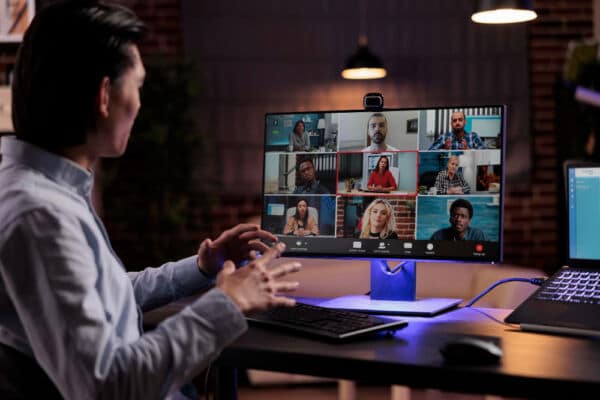Hybrid events have emerged as a powerful tool to bridge the gap between in-person and virtual experiences. These events offer the flexibility of remote participation while retaining the personal touch of face-to-face interactions. This dual approach not only broadens the audience reach but also enhances overall engagement. As companies adapt to new ways of working, hybrid events provide an inclusive solution that caters to diverse employee preferences and geographical constraints. They allow businesses to connect with a global audience while maintaining the benefits of traditional, in-person gatherings.
This article explores the planning, execution, and successful integration of hybrid events, focusing on how HR professionals can effectively balance both formats to create seamless and engaging experiences for all employees. From understanding the core components of hybrid events to implementing best practices for engagement and technical support, we cover everything you need to know to host a successful hybrid event.
Image by DC Studio on Freepik
Understanding Hybrid Events
Hybrid events combine in-person and virtual elements, allowing participants to choose their preferred mode of attendance. This versatility ensures higher participation rates and accommodates various preferences and constraints. For businesses, hybrid events can maximize reach, making them a popular choice for corporate event solutions. These events typically feature synchronized activities, interactive sessions, and integrated technology that bridges the physical and digital divide. By providing multiple participation options, hybrid events can cater to a wider audience and foster greater inclusivity.
The key to a successful hybrid event lies in understanding its core components. Synchronized activities ensure that both in-person and virtual participants have access to the same content simultaneously. Interactive sessions, such as live Q&A and polls, engage attendees and encourage participation. Integrated technology facilitates seamless communication and interaction between all participants, regardless of their location. This multi-faceted approach ensures that hybrid events are not only accessible but also engaging and effective.
Planning a Hybrid Event
Planning a hybrid event requires meticulous coordination and clear objectives. HR professionals must outline the event’s goals and identify key performance indicators (KPIs) to measure success. The selection of a suitable platform is crucial for the virtual aspect, ensuring it supports interactive features and reliable connectivity. For the in-person segment, choosing a venue that offers necessary technical infrastructure is vital. Detailed planning also involves creating a comprehensive event timeline that includes both virtual and physical activities, ensuring they are synchronized to provide a cohesive experience.
Setting clear objectives helps in defining the event’s purpose and measuring its outcomes. For instance, an event aimed at employee training will have different goals and KPIs compared to a product launch or a networking session. Choosing the right platform involves researching and selecting one that offers features such as live streaming, interactive polls, Q&A sessions, and networking lounges. The venue for the in-person component should be equipped with the necessary technology to support live streaming and other digital interactions, ensuring that remote participants have a seamless experience.
- Clear objectives. Define purpose and KPIs.
- Suitable platform. Ensure robust features and connectivity.
- Appropriate venue. Support for necessary technology.
Communication is another critical aspect of planning. Clear and consistent communication with all stakeholders, including speakers, participants, and technical teams, is essential. This ensures everyone is on the same page and can contribute to the event’s success. Additionally, a detailed agenda should be shared with all participants well in advance, outlining the schedule and providing instructions on how to join sessions. This transparency helps in setting expectations and reducing any potential confusion.
Ensuring Seamless Integration Between In-Person and Virtual Experiences
Achieving seamless integration between in-person and virtual experiences is crucial for a successful hybrid event. This involves synchronizing activities and maintaining consistent engagement across both formats. Clear communication channels and real-time interactions help create a unified experience. Synchronizing activities means planning a schedule that allows both in-person and virtual attendees to participate simultaneously, with live streaming being used to broadcast in-person sessions to virtual participants.
Utilizing event management platforms can significantly streamline the process of integrating in-person and virtual experiences by offering features like unified scheduling and centralized communication tools. These platforms often provide real-time analytics, helping organizers monitor engagement and make necessary adjustments promptly. Additionally, they can enhance the attendee experience through personalized agendas and seamless access to both live and recorded sessions. Just take a look, for instance, at RegFox corporate event registration and attendee management platform, and you’ll see features that can help with such integration.
Maintaining consistent engagement requires encouraging interaction through various means, such as polls, chat rooms, and Q&A sessions. Providing real-time updates and support to all attendees ensures that everyone feels involved and connected. Facilitating clear communication involves informing all participants about the event agenda and how to access sessions, using multiple communication channels, including email, SMS, and app notifications. This comprehensive approach helps in bridging the gap between physical and virtual experiences, making the event more inclusive and engaging.
One of the challenges in integrating both formats is ensuring that virtual participants feel as engaged and valued as those attending in person. This can be achieved by incorporating elements such as virtual networking lounges, where remote attendees can interact with each other and with in-person participants. Additionally, using technology like augmented reality (AR) and virtual reality (VR) can provide immersive experiences that bring both groups together. These technologies can be used for virtual tours, interactive exhibits, and even social activities, enhancing the overall experience.
Engaging Remote Participants
Engaging remote participants can be challenging but is essential for a successful hybrid event. Best practices include using interactive tools, offering networking opportunities, and ensuring that remote attendees feel included and valued. Interactive tools such as polls and Q&A sessions can be used to encourage participation and make virtual sessions more engaging. Incorporating gamification elements can also enhance engagement by making the experience more fun and interactive.
Providing networking opportunities is another key aspect of engaging remote participants. Virtual networking lounges and breakout rooms can facilitate meaningful interactions, allowing remote attendees to connect with their peers. Facilitating one-on-one meetings and group discussions can also help in building a sense of community among remote participants. Inclusivity can be achieved by recognizing remote attendees during sessions and involving them in discussions. Offering virtual swag bags and other incentives can further enhance their experience and make them feel valued.
A successful engagement strategy also involves offering content that is specifically tailored to remote participants. This could include exclusive sessions, behind-the-scenes access, or special Q&A sessions with key speakers. By providing unique content that is only available to virtual attendees, event organizers can make remote participants feel special and appreciated. Additionally, ensuring that all content is accessible, with features like closed captioning and language options, can further enhance the experience for a diverse audience.
Enhancing In-Person Experience
Creating a memorable and engaging environment for in-person attendees is equally important. Incorporating technology to connect with virtual participants and ensuring safety and comfort are key elements. Designing the venue layout to encourage interaction and comfort can make the in-person experience more enjoyable. Using technology such as large screens and interactive kiosks can help in connecting in-person attendees with virtual participants, creating a more integrated experience.
Ensuring safety involves implementing health protocols such as sanitization stations and social distancing. Providing clear guidelines on health and safety measures to all attendees can help in making them feel safe and comfortable. Organizing interactive sessions that allow in-person participants to interact with virtual ones can further enhance engagement. Using augmented reality (AR) and virtual reality (VR) can provide immersive experiences that bridge the gap between physical and digital environments.
- Comfortable environment. Design venue layout effectively.
- Health and safety. Implement necessary protocols.
- Interactive sessions. Connect in-person and virtual attendees.
Technical Considerations and Challenges
Technical reliability is fundamental to the success of a hybrid event. Ensuring robust internet connectivity and having a dedicated technical support team can prevent disruptions and enhance the overall experience. Securing a reliable internet connection for both the venue and the virtual platform is crucial. Testing the connection before the event and having backups in place can help in preventing technical issues.
Providing real-time technical support for all participants is also essential. Offering tutorials and guides on how to use the virtual platform can help in addressing any technical challenges that participants might face. Preparing contingency plans for potential technical issues can further ensure a smooth experience. Having alternative methods for participants to access the event, such as backup links or recordings, can also help in mitigating the impact of technical problems.
To further minimize technical challenges, it’s important to conduct thorough rehearsals and dry runs. This involves testing all equipment, software, and internet connections to identify and resolve any potential issues before the event begins. Additionally, having a dedicated technical team on standby during the event can ensure that any problems are addressed promptly. Clear communication with participants regarding how to access technical support and troubleshoot common issues can also help in reducing disruptions and ensuring a seamless experience.
Conclusion
Hybrid events represent a dynamic approach to corporate gatherings, balancing the benefits of in-person interactions with the convenience of virtual participation. By focusing on meticulous planning, seamless integration, and robust technical support, HR professionals can create engaging and memorable hybrid events that cater to all employees. Embracing this format not only enhances participation but also paves the way for more inclusive and flexible corporate events in the future.







Leave A Comment